Seeing on new Subarus, pzev, partial zero emissions vehicle. WTH is that?! All my vehicles are pzevs, at this very moment they are not producing any emissions!
(2)Monthly Archive for April, 2014
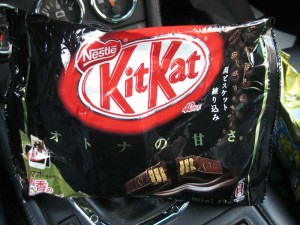 Nestle Japan makes innumerable regional variations of the Kit Kat chocolate-covered biscuit candy, usually borrowing the flavor of the coating from the local specialty food, whether that be strawberry, green tea, melon, wasabi, sweet potato, or even soy sauce! While killing time at the airport before my return flight, I saw some boring flavors that I’ve had before or are available at Don Quijote on Kaheka, then I saw these. From the get-go, the katakana “otona” for “adult” caught my eye. Adult? What, is it like naughty or something? I couldn’t read the kanji, though it seemed vaguely familiar. The package was dark, and the images of the candy seemed darker than the usual milk chocolate, so I figured what they meant by “adult” was these were a less-sweet dark chocolate version. I threw them in my Kifaru after buying them and forgot about them until a couple days ago. Continue reading ‘Edible Briefs – Nestle Japan Otona no Amasa Kit Kat’
Nestle Japan makes innumerable regional variations of the Kit Kat chocolate-covered biscuit candy, usually borrowing the flavor of the coating from the local specialty food, whether that be strawberry, green tea, melon, wasabi, sweet potato, or even soy sauce! While killing time at the airport before my return flight, I saw some boring flavors that I’ve had before or are available at Don Quijote on Kaheka, then I saw these. From the get-go, the katakana “otona” for “adult” caught my eye. Adult? What, is it like naughty or something? I couldn’t read the kanji, though it seemed vaguely familiar. The package was dark, and the images of the candy seemed darker than the usual milk chocolate, so I figured what they meant by “adult” was these were a less-sweet dark chocolate version. I threw them in my Kifaru after buying them and forgot about them until a couple days ago. Continue reading ‘Edible Briefs – Nestle Japan Otona no Amasa Kit Kat’
 Found a new place for gyu-tan in Sapporo, actually in a very convenient location. If you know where the Mexican restaurant in the JR Sapporo-eki Paseo B1 arcade is, it’s North of that in the newly remodeled area. I got the kakuni-don teishoku (1500-yen), which of course had a donburi topped with kakuni (soy-sauce-braised pork belly), a salad, tail soup (clear oxtail soup with julienned green onions), and a side of charbroiled gyu-tan. In all honesty, the kakuni was not very good. I really should have just gotten the gyu-tan-don (1300-yen). The gyu-tan, tsukemono, salad and tail soup were all very good. There was an evil nuka-zuke togarashi (pickled hot pepper) that packed a pretty good burn that was nestled amongst the pickles. I was a little surprised that it wasn’t that busy, but I was there at 13:30, so I probably just missed the lunch crowd. Service was fast and competent. Ingredient quality was very good. There’s no English menu, but pointing works. Continue reading ‘Edible Briefs – Gyu-tan Sumiyaki Kikyu’
Found a new place for gyu-tan in Sapporo, actually in a very convenient location. If you know where the Mexican restaurant in the JR Sapporo-eki Paseo B1 arcade is, it’s North of that in the newly remodeled area. I got the kakuni-don teishoku (1500-yen), which of course had a donburi topped with kakuni (soy-sauce-braised pork belly), a salad, tail soup (clear oxtail soup with julienned green onions), and a side of charbroiled gyu-tan. In all honesty, the kakuni was not very good. I really should have just gotten the gyu-tan-don (1300-yen). The gyu-tan, tsukemono, salad and tail soup were all very good. There was an evil nuka-zuke togarashi (pickled hot pepper) that packed a pretty good burn that was nestled amongst the pickles. I was a little surprised that it wasn’t that busy, but I was there at 13:30, so I probably just missed the lunch crowd. Service was fast and competent. Ingredient quality was very good. There’s no English menu, but pointing works. Continue reading ‘Edible Briefs – Gyu-tan Sumiyaki Kikyu’
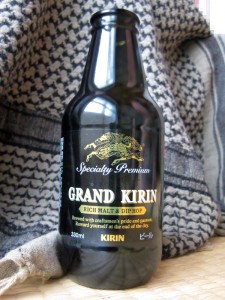 Kirin is generally the last of the major Japanese commercial beer manufacturers on my list, so you can guess how desperate or bored I was to pick this one up. I’ve had several of the Kirin premium line bottled beers before, and in general these are distinct in flavor profile from the standard Kirin Ichiban Shibori, but they still fall short of impressing me. The Grand Kirin is no exception. The label calls out, “rich malt and dip hop,” but this is not mirrored anywhere on the label in Nihongo in any writing system. I find this odd. There was another similar bottle labeled, “aroma hop,” or something, so the Japanese consumer has to differentiate the two (or possibly more) of the Kirin premium products by the English or label color? Continue reading ‘Beer is Good – Grand Kirin’
Kirin is generally the last of the major Japanese commercial beer manufacturers on my list, so you can guess how desperate or bored I was to pick this one up. I’ve had several of the Kirin premium line bottled beers before, and in general these are distinct in flavor profile from the standard Kirin Ichiban Shibori, but they still fall short of impressing me. The Grand Kirin is no exception. The label calls out, “rich malt and dip hop,” but this is not mirrored anywhere on the label in Nihongo in any writing system. I find this odd. There was another similar bottle labeled, “aroma hop,” or something, so the Japanese consumer has to differentiate the two (or possibly more) of the Kirin premium products by the English or label color? Continue reading ‘Beer is Good – Grand Kirin’
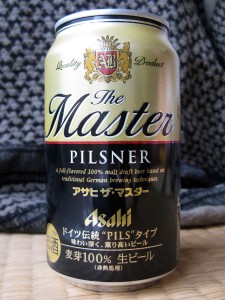 I’ve seen this a few times at the supermarket, but have always passed it up because it was an Asahi. With no current varietals from Sapporo/Yebisu or Suntory, I picked one up. Like Asahi’s Super Dry lager, this pilsen doesn’t have any objectionable traits. The pour reveals a slightly deeper color than a standard Japanese lager, hinting at a more intensely flavored decoction, but the head is the expected transient film. On first taste, there is the dry bubbliness across the tongue that Asahi prides themselves on, and as expected the malt flavor is especially rich and is quickly followed up by a strong bitter. Japanese beers are formulated to go with food, and this is no exception: It almost demands an accompaniment! It went very well with my spicy char-siu don. This is a great beer and is on approximately even standing with the Suntory Malts Premium Pilsner. It would be interesting to do a head-to-head with the two! Continue reading ‘Beer is Good – Asahi The Master Pilsner’
I’ve seen this a few times at the supermarket, but have always passed it up because it was an Asahi. With no current varietals from Sapporo/Yebisu or Suntory, I picked one up. Like Asahi’s Super Dry lager, this pilsen doesn’t have any objectionable traits. The pour reveals a slightly deeper color than a standard Japanese lager, hinting at a more intensely flavored decoction, but the head is the expected transient film. On first taste, there is the dry bubbliness across the tongue that Asahi prides themselves on, and as expected the malt flavor is especially rich and is quickly followed up by a strong bitter. Japanese beers are formulated to go with food, and this is no exception: It almost demands an accompaniment! It went very well with my spicy char-siu don. This is a great beer and is on approximately even standing with the Suntory Malts Premium Pilsner. It would be interesting to do a head-to-head with the two! Continue reading ‘Beer is Good – Asahi The Master Pilsner’
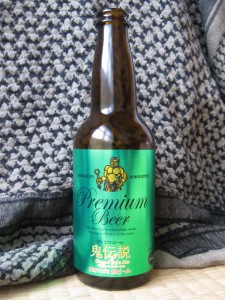 While in Noboribetsu, I happened upon a new varietal from Noboribetsu Beer. I’ve had their Ao-oni pilsnener (gold can) and Aka-oni red ale (red can), but this green-labeled glass bottle was a first. Being in bottles instead of cans, I was not taking the chance of bringing any back on the plane, so I just got enough for my immediate use. Named the Kin’oni (gold demon) Pale Ale, it is described on the label as an “American type pale ale”. Cracking the cap, there was only a light hiss of pressure. Since Nobiribetsu Beer’s products are all non-pasteurized bottle/can conditioned craft beers, this worried me a little. These worries were short lived. After pouring the deep amber beer and taking the first taste, my fears were gone. The mouthfeel was the heaviest amongst their other offerings, with a rich caramel malt flavor backed up with a strong hopping. The hops used were both bitter and flowery, giving the ale an overall fruity flavor and aroma. They weren’t being timid with this one! The carbonation level was low. This beer pairs well with salty foods or red meat where the sweetness of the hopping stands up to heavier, savory food flavors, and the bitter finish refreshes the palate, but this beer truly shines when enjoyed unaccompanied. Continue reading ‘Beer is Good – Noboribetsu Beer Onidensetsu Kin’oni Pale Ale’
While in Noboribetsu, I happened upon a new varietal from Noboribetsu Beer. I’ve had their Ao-oni pilsnener (gold can) and Aka-oni red ale (red can), but this green-labeled glass bottle was a first. Being in bottles instead of cans, I was not taking the chance of bringing any back on the plane, so I just got enough for my immediate use. Named the Kin’oni (gold demon) Pale Ale, it is described on the label as an “American type pale ale”. Cracking the cap, there was only a light hiss of pressure. Since Nobiribetsu Beer’s products are all non-pasteurized bottle/can conditioned craft beers, this worried me a little. These worries were short lived. After pouring the deep amber beer and taking the first taste, my fears were gone. The mouthfeel was the heaviest amongst their other offerings, with a rich caramel malt flavor backed up with a strong hopping. The hops used were both bitter and flowery, giving the ale an overall fruity flavor and aroma. They weren’t being timid with this one! The carbonation level was low. This beer pairs well with salty foods or red meat where the sweetness of the hopping stands up to heavier, savory food flavors, and the bitter finish refreshes the palate, but this beer truly shines when enjoyed unaccompanied. Continue reading ‘Beer is Good – Noboribetsu Beer Onidensetsu Kin’oni Pale Ale’
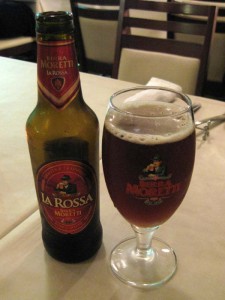 This is one of the two easily available Moretti products on the worldwide market. I’ve seen it referred to as “Moretti Dark” at Verbano, but a more apt description for this doppio (double) would be “Moretti Strong” with its higher alcohol content and robust flavor. The decoction was strong and the hopping was more sweet than bitter. The initial taste was that sweet that faded into an understated malt, then a slight astringency in the fade to the finish. This doppelbock wasn’t syrupy, but it did have a thicker mouthfeel than the standard Moretti offering. The carbonation was low and head short-lived. The heavier, sweeter taste of this beer works well with veal and heavier marinara sauces, but doesn’t go that well with delicately flavored dishes like carpaccio or pasta or entrees with cream sauces. I’ll still choose a Peroni over either of the Moretti beers if given the choice. Continue reading ‘Beer is Good – Moretti La Rossa’
This is one of the two easily available Moretti products on the worldwide market. I’ve seen it referred to as “Moretti Dark” at Verbano, but a more apt description for this doppio (double) would be “Moretti Strong” with its higher alcohol content and robust flavor. The decoction was strong and the hopping was more sweet than bitter. The initial taste was that sweet that faded into an understated malt, then a slight astringency in the fade to the finish. This doppelbock wasn’t syrupy, but it did have a thicker mouthfeel than the standard Moretti offering. The carbonation was low and head short-lived. The heavier, sweeter taste of this beer works well with veal and heavier marinara sauces, but doesn’t go that well with delicately flavored dishes like carpaccio or pasta or entrees with cream sauces. I’ll still choose a Peroni over either of the Moretti beers if given the choice. Continue reading ‘Beer is Good – Moretti La Rossa’
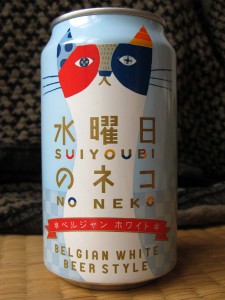 This is another beer that I’ve seen a few times but never tried. I came across it again while trying to search for Kawaba using “Japanese weiss” as search terms. I shortlisted it for a taste test. All I needed was the chance to get one, and on the way back from Noboribetsu, I got the chance. The “cat beer” can is unmistakable. It does make one ponder who the intended market for this beer is. The same brewery also makes Yona Yona Ale and Tokyo Black beer. Neither of these sounded that intriguing, especially when I already had some special brews from Noboribetsu Beer already in my pack, so I just got the cat.
This is another beer that I’ve seen a few times but never tried. I came across it again while trying to search for Kawaba using “Japanese weiss” as search terms. I shortlisted it for a taste test. All I needed was the chance to get one, and on the way back from Noboribetsu, I got the chance. The “cat beer” can is unmistakable. It does make one ponder who the intended market for this beer is. The same brewery also makes Yona Yona Ale and Tokyo Black beer. Neither of these sounded that intriguing, especially when I already had some special brews from Noboribetsu Beer already in my pack, so I just got the cat.
Now as to the brewery, the katakana on the can has them as “Yahou”, like as you’d call out from a mountaintop. The website listed on the can is the romaji “yohobrewing dot com”. When you go to the site, they use the romaji “Yo-ho”. Seriously? Do they not know themselves what their own company name is? Continue reading ‘Beer is Good – Yoho Suiyoubi no Neko Belgian Ale’
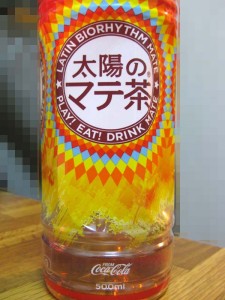 The Coca Cola company has introduced a bottled Yerba Mate drink in the Japanese market. Sold as an unsweetened tea, there is no indication on the bottle that it contains caffeine, so you’re left to your own knowledge as to what Mate contains. The specific Yerba Mate they use is fairly mild: It is lightly smoked, so it doesn’t have the “green” taste of unsmoked leaves common in American health-food markets nor the strong smokiness of traditional Argentinian leaves. If not for the label, you might think you’re drinking a lighter houji-cha. I like it. The English, “Latin biorhythm Mate, Play! Eat! Drink Mate,” marketing text is a little weird though. Go figure – this is Japan!
The Coca Cola company has introduced a bottled Yerba Mate drink in the Japanese market. Sold as an unsweetened tea, there is no indication on the bottle that it contains caffeine, so you’re left to your own knowledge as to what Mate contains. The specific Yerba Mate they use is fairly mild: It is lightly smoked, so it doesn’t have the “green” taste of unsmoked leaves common in American health-food markets nor the strong smokiness of traditional Argentinian leaves. If not for the label, you might think you’re drinking a lighter houji-cha. I like it. The English, “Latin biorhythm Mate, Play! Eat! Drink Mate,” marketing text is a little weird though. Go figure – this is Japan!
When I saw the new taillights of the mid-cycle refresh of the Camaro, I thought it looked pretty good. Seeing it again though, it made me think that the car looked like a swollen Nissan Silvia S13.
(0)